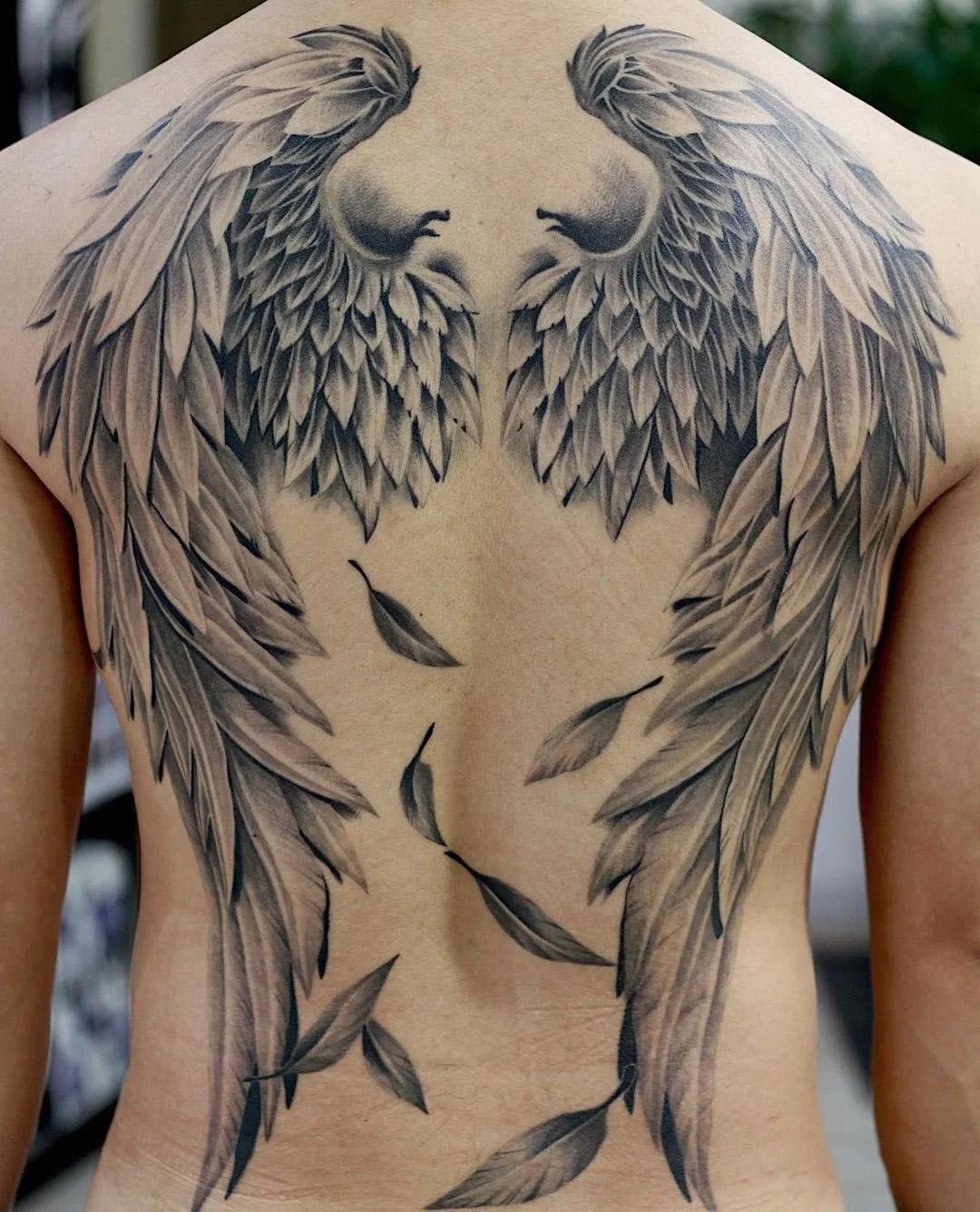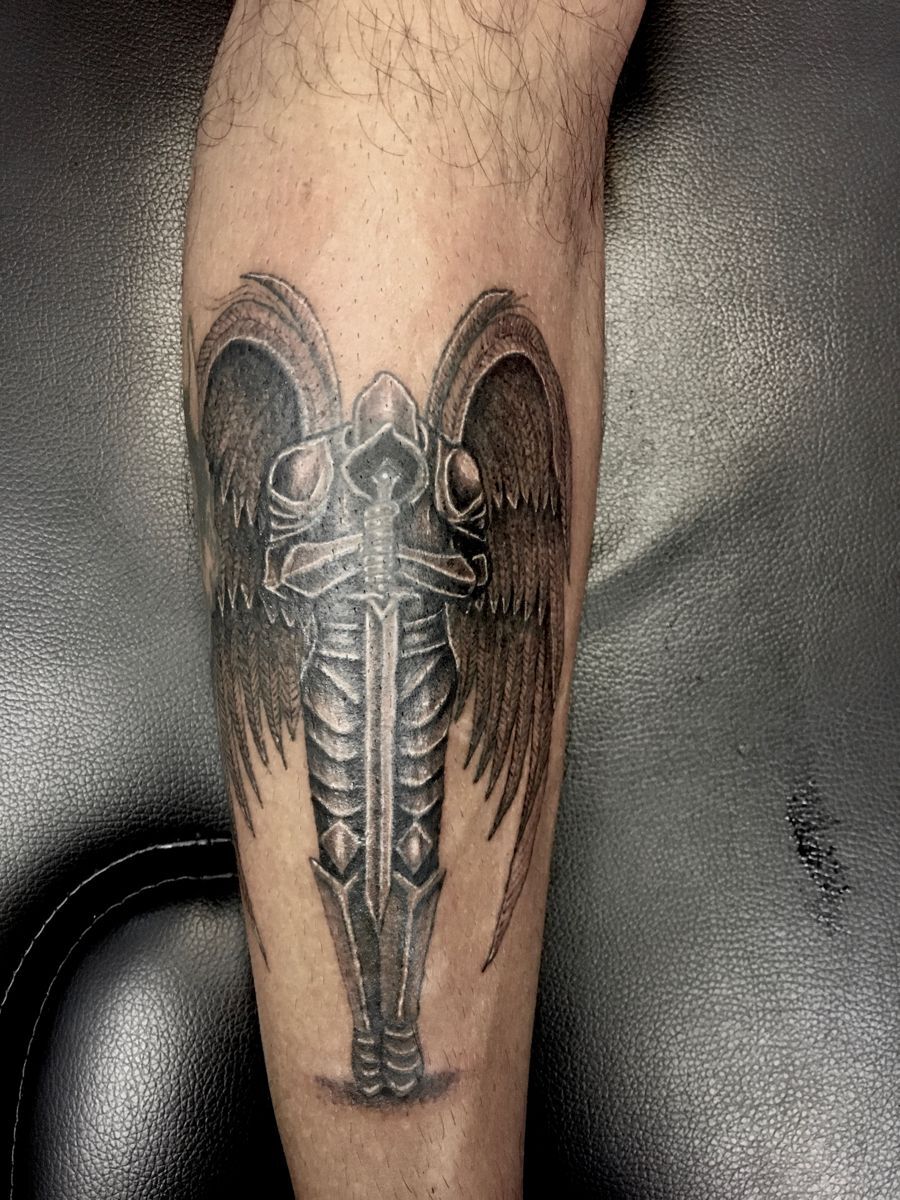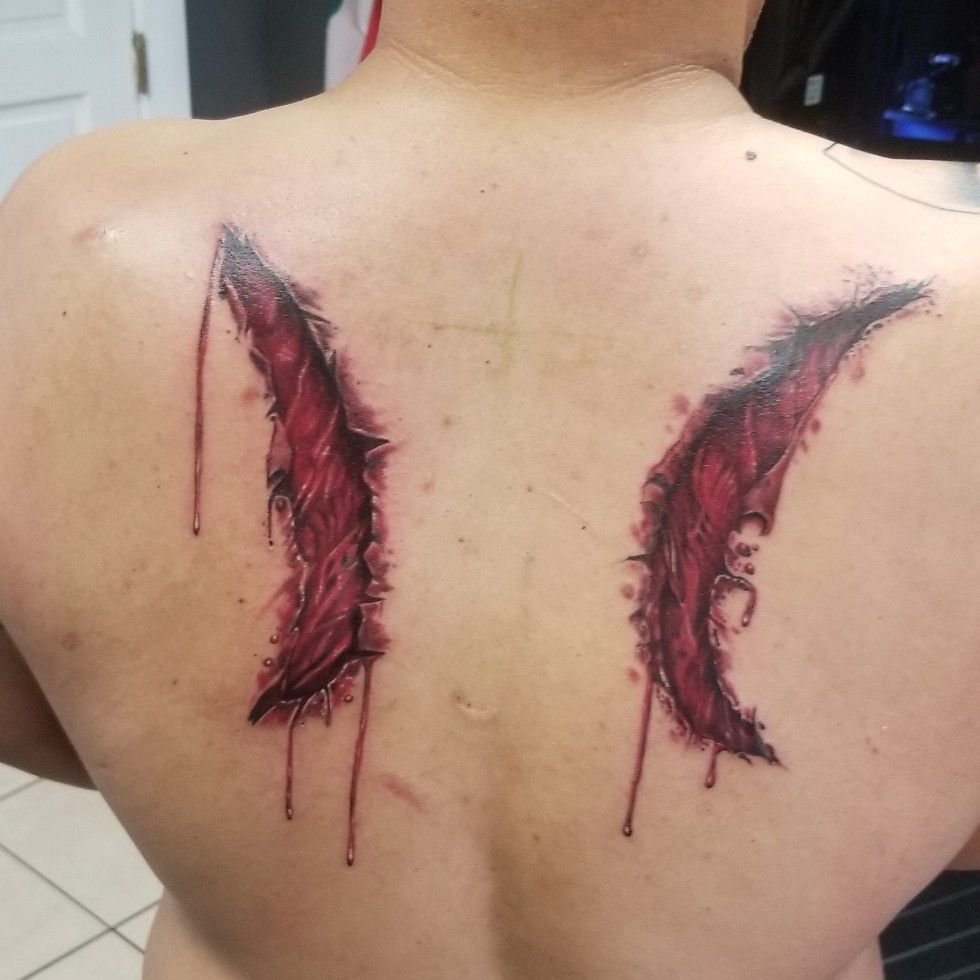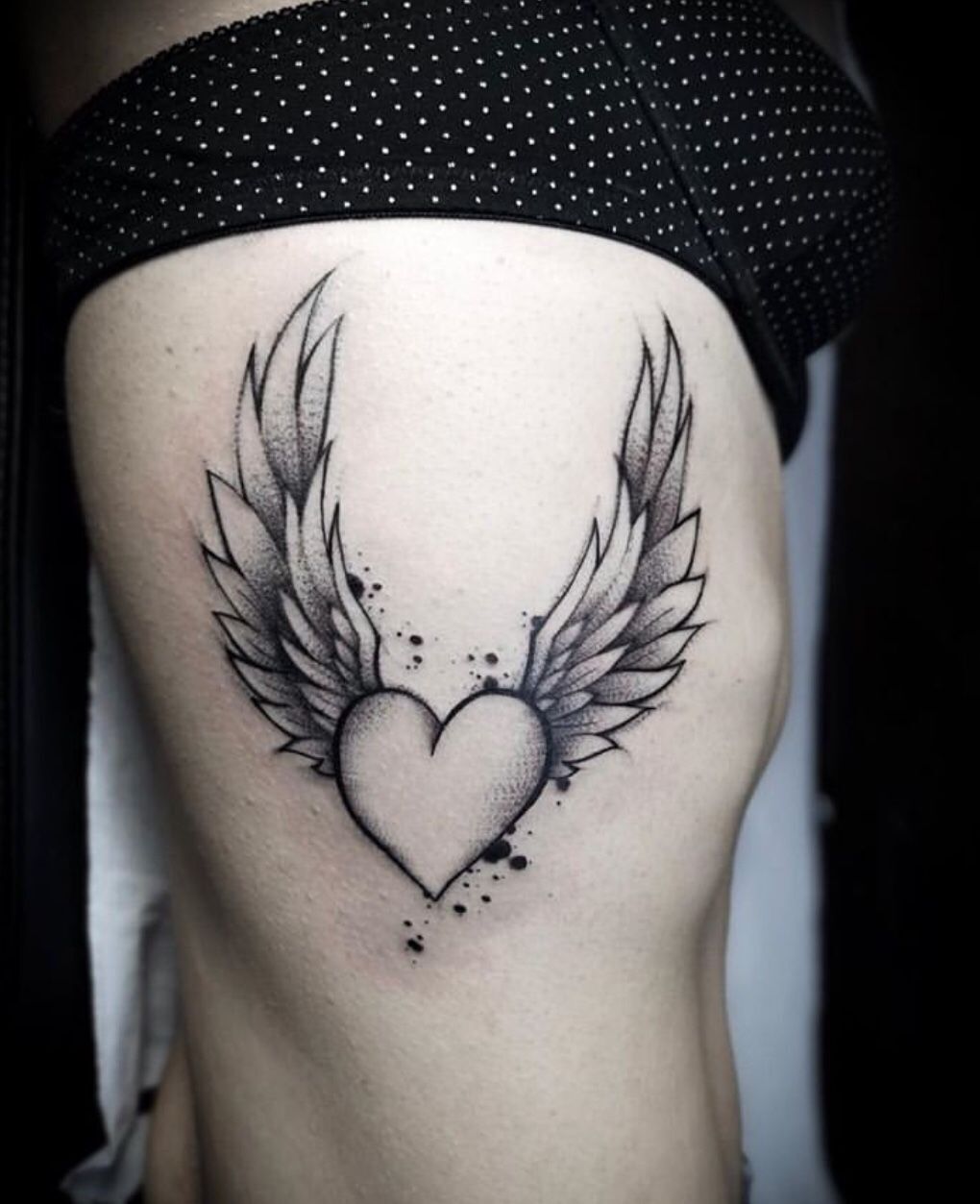Angel wings tattoos are a popular tattoo design that has been around for many years. They are a symbol of spirituality, protection, and divine inspiration. Angel wings tattoos can be a beautiful and meaningful addition to any tattoo collection.
Are you only interested in tattoo designs and want to skip the educational part?
No problem, we got you covered! Click HERE to get inspired.
What do angel wings symbolize?
Angel wings symbolize divine protection, guidance, and love in many cultures and religions. They are often seen as a sign of the presence of higher powers or spiritual entities, such as angels, who are believed to help guide and protect humans throughout their lives.
Angel wings also represent purity, innocence, and spirituality, symbolizing the transcendent nature of the divine. Furthermore, they symbolize freedom and the ability to transcend physical constraints, implying spiritual elevation or enlightenment. In the context of death or loss, angel wings can symbolize the belief in the soul's ascent to heaven or an afterlife.
Thus, the symbolism of angel wings can vary greatly depending on the context, but it generally revolves around notions of divine guidance, protection, and spiritual elevation.
What is the meaning behind angel wings tattoos?
Angel wings tattoos often represent spiritual guidance, divine protection, and freedom, similar to the symbolism of angel wings in general.
When someone chooses an angel wings tattoo, it could signify their belief in a higher power or their reliance on divine guidance in life. It could also embody a sense of purity and innocence.
The angel wings tattoo can signify the freedom to transcend physical limitations and challenges, symbolizing spiritual ascent or enlightenment. In some cases, these tattoos are worn in memory of a loved one who has passed, symbolizing the belief in their ascent to a heavenly afterlife.
Therefore, the meaning behind angel wings tattoos is deeply personal and can vary depending on the wearer's beliefs and experiences.
best angel wings tattoo ideas and their meanings
Angel wings tattoos have long been admired for their beauty and profound symbolism. These tattoos can serve as a reflection of personal beliefs, experiences, or aspirations, and can carry diverse meanings for different individuals. Here are the top five rated angel wings tattoo ideas along with their common interpretations.
Full Back Angel Wings tattoo
This grand tattoo design covers the whole back with large, detailed wings spreading out from the center. It symbolizes personal freedom, spiritual elevation, and the aspiration to rise above earthly challenges.
Guardian Angel Tattoo
Often depicted as a full figure or just the wings of an angel, this tattoo represents protection, guidance, and the belief in a divine entity watching over the wearer.
Broken or Fallen Angel Wings tattoo
This design carries a more melancholic tone, representing personal struggles, loss, or the fight against inner demons. It can also symbolize the idea of a fallen angel, referring to defiance or rebellion.
Angel Wings with Halo tattoo
A halo added to the angel wings imbues the design with extra spirituality. It often represents purity, innocence, and divine connection, and might be used to commemorate a loved one who has passed away.
Heart with Angel Wings tattoo
This sweet and touching design combines a heart with angel wings, signifying loving protection, divine love, or the freedom to love. It can also represent the loss of a loved one, with the heart symbolizing the departed soul flying towards heaven.
Who should get an angel wings tattoo?
An angel wings tattoo is a versatile design that can appeal to a wide range of individuals due to its profound symbolism and aesthetic appeal. It can be an ideal choice for someone who holds strong spiritual or religious beliefs, especially those who associate with the concepts of divine guidance, protection, and love symbolized by angel wings. Additionally, those who value personal freedom, spiritual elevation, or overcoming challenges may also find this design meaningful.
An angel wings tattoo can also be a comforting symbol for those who have experienced loss, as it can represent the soul's ascent to heaven or an afterlife, making it a poignant memorial for a departed loved one. People who appreciate the beauty of angelic imagery or who wish to express a sense of purity, innocence, or rebellion might also consider this design. Ultimately, the decision to get an angel wings tattoo should be a deeply personal one, reflecting the wearer's unique experiences, beliefs, and values.
General Breakdown Of Tattoo Pain Levels On Different Body Parts
Here is a breakdown of the different tattoo pain levels:
- Low: This level of pain is generally described as a mild discomfort or tickling sensation. It is similar to the sensation of getting a light scratch or scrape.
- Moderate: This level of pain is generally described as a moderate discomfort or aching sensation. It is similar to the sensation of getting a deep scratch or scrape or being pinched.
- High: This level of pain is generally described as a strong discomfort or throbbing sensation. It is similar to the sensation of getting a burn or being stung by a bee.
It's important to note that pain tolerance is highly individual and can vary greatly from person to person. Some people may find certain body parts more or less painful than others, and the same body part can be more or less painful for different people. Additionally, the level of pain can be affected by factors such as the size and location of the tattoo, the skill of the tattoo artist, and the individual's own pain threshold.
Tattoo placement pain level chart
Body Part | Pain Level | Explanation |
Forehead | Low | The forehead has few nerve endings, so it is not a particularly painful area. |
Eyebrows | Low | The eyebrows have few nerve endings, so the pain level is relatively low. |
Ear | Low | The ear is a relatively thin and fleshy area, so the pain level is low. |
Nostril | Low | The nostril is a small area with thin skin, so the pain level is low. |
Lip | Low to Moderate | The lip has more nerve endings than some other areas, so it may be slightly more painful. |
Cheek | Low to Moderate | The cheek has a moderate amount of nerve endings, so it may be slightly more painful. |
Moderate | The neck has a moderate amount of nerve endings, so it may be slightly more painful. | |
Moderate to High | The chest has a high concentration of nerve endings, so it can be quite painful. | |
Abdomen | High | The abdomen has a high concentration of nerve endings, so it can be quite painful. |
Back | High | The back has a high concentration of nerve endings, so it can be quite painful. |
Shoulders | High | The shoulders have a high concentration of nerve endings, so they can be quite painful. |
Upper Arms | Moderate to High | The upper arms have a moderate to high concentration of nerve endings, so they can be somewhat painful. |
Elbows | High | The elbows have a high concentration of nerve endings, so they can be quite painful. |
Forearms | Moderate | The forearms have a moderate concentration of nerve endings, so they are not as painful as some other areas. |
Hands | High | The hands have a high concentration of nerve endings, so they can be quite painful. |
Lower Arms | Low to Moderate | The lower arms have a lower concentration of nerve endings, so they are not as painful as some other areas. |
Wrists | Low | The wrists have a low concentration of nerve endings, so they are not very painful. |
Lower Back | High | The lower back has a high concentration of nerve endings, so it can be quite painful. |
Buttocks | High | The buttocks have a high concentration of nerve endings, so they can be quite painful. |
Thighs | High | The thighs have a high concentration of nerve endings, so they can be quite painful. |
Knees | High | The knees have a high concentration of nerve endings, so they can be quite painful. |
Calves | Low to Moderate | The calves have a low to moderate concentration of nerve endings, so they are not as painful as some other areas. |
Ankles | Low | The ankles have a low concentration of nerve endings, so they are not very painful. |
Tattoo aftercare tips
Before getting a tattoo:
Choose a reputable tattoo artist and parlor. Research the artist's portfolio and read reviews from previous clients.
Consult with the artist about the design and placement of the tattoo.
Make sure you are in good health. If you have any medical conditions or are taking any medications that may affect your ability to heal, be sure to let your tattoo artist know.
Consider using a numbing cream to reduce pain during the tattooing process. These creams contain a numbing agent (such as lidocaine) that can be applied to the skin before the tattoo is done. It's important to follow the instructions on the numbing cream and to only use it as directed.
Avoid alcohol, caffeine, and other substances that can thin your blood for at least 24 hours before getting a tattoo.
Eat a healthy meal before your tattoo session to ensure that your blood sugar is stable.
Wear loose, comfortable clothing that allows easy access to the area being tattooed.
After getting a tattoo:
Follow the aftercare instructions provided by your tattoo artist. These may include:
Keeping the tattoo clean and covered with a bandage for the first few hours after getting tattooed.
Washing the tattoo with lukewarm water and a mild soap (such as unscented, antimicrobial soap) and patting it dry with a clean towel.
Applying a thin layer of tattoo ointment or lotion (such as A&D or Aquaphor) to the tattoo and covering it with a clean bandage or wrap.
Repeating this process for the first few days, or until the tattoo has fully scabbed over.
Avoid soaking the tattoo in water for the first week, such as in a bath or pool.
Avoid picking or scratching at the scabs, as this can cause the tattoo to fade or become infected.
Avoid exposure to direct sunlight or tanning beds for at least 2-4 weeks.
If you experience any redness, swelling, or unusual discharge, contact your tattoo artist or a healthcare professional.
Overall, it's important to keep your tattoo clean and moisturized during the healing process to ensure that it heals properly and looks its best. Using a numbing cream can help reduce pain during the tattooing process, but it's important to use it as directed and to follow all aftercare instructions to ensure that your tattoo heals properly.
People Also Ask:
What is the symbolism of angel wings?
Angel wings are often seen as symbols of divine protection, guidance, and love. They also represent purity, innocence, spirituality, freedom, and the transcendence of physical constraints. In some contexts, they symbolize the belief in a soul's ascent to heaven or the afterlife.
What is the meaning behind angel wings tattoos?
An angel wings tattoo often signifies spiritual guidance, divine protection, and freedom. It may also represent purity and innocence, as well as the freedom to transcend physical limitations and challenges. In memory of a loved one who has passed, it can symbolize their ascent to a heavenly afterlife.
What are some of the top-rated angel wings tattoo designs and their meanings?
Some popular designs include the full back angel wings representing personal freedom and spiritual elevation, guardian angel tattoo for divine protection, broken or fallen angel wings for personal struggles, angel wings with a halo for purity and divine connection, and heart with angel wings for divine love or memorial of a departed soul.
Who should consider getting an angel wings tattoo?
People who hold strong spiritual or religious beliefs, value personal freedom and spiritual growth, or wish to memorialize a loved one may consider an angel wings tattoo. It can also be a fitting choice for those who appreciate the beauty of angelic imagery or wish to express a sense of purity, innocence, or rebellion.
Does the size of an angel wings tattoo matter?
The size of the tattoo can depend on personal preference and the intended symbolism. Larger designs, like a full-back angel wings tattoo, can represent grand concepts like personal freedom and spiritual elevation, while smaller designs can be more intimate, representing personal guidance and protection.
Are angel wings tattoos for men and women alike?
Yes, angel wings tattoos are universal and can be chosen by anyone regardless of gender. The interpretation and design can be customized to reflect the personal beliefs and experiences of the wearer.
Can the design of an angel wings tattoo change its meaning?
Yes, the design elements incorporated into an angel wings tattoo can change its meaning. For example, broken wings can symbolize struggle or defiance, while a heart with wings can symbolize love and loss.
Is it disrespectful to get an angel wings tattoo?
Generally, it's not considered disrespectful to get an angel wings tattoo. However, the interpretation can vary depending on cultural and personal beliefs. As with any symbol with religious or cultural significance, it's always good to understand the meanings and connotations before choosing the design.
How should I choose the location for my angel wings tattoo?
The location of the tattoo is largely dependent on personal preference, tattoo design, and how visible you want it to be. Common places for angel wings tattoos include the back, chest, forearm, and shoulder.
What is the process of getting an angel wings tattoo?
After deciding on the design and location, you should consult with a professional tattoo artist to discuss the design's feasibility, potential pain level, and aftercare procedures. It's important to choose a reputable tattoo artist to ensure proper hygiene and safety practices are followed.
Watch A video of a angel wings tattoo done by a pro
200+ angel wings tattoo Ideas to get inspired from
Final thoughts
Angel wings tattoos are a beautiful and meaningful tattoo design that can symbolize protection, guidance, and spirituality. With their timeless appeal, angel wings tattoos can be a significant and personal addition to any tattoo collection. Whether you choose a simple and elegant design or a more elaborate and colorful design, angel wings tattoos can be customized to suit your taste and style.






